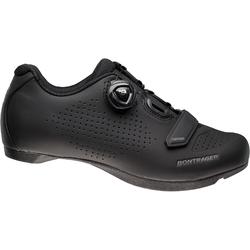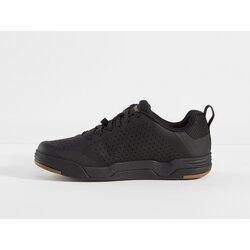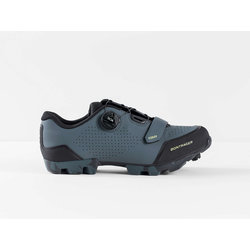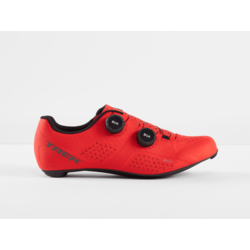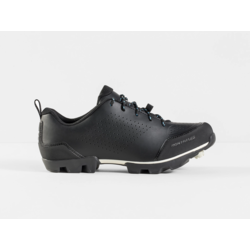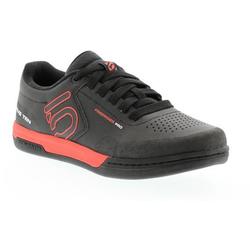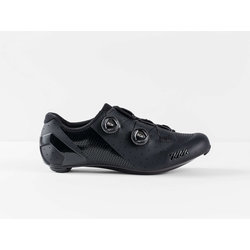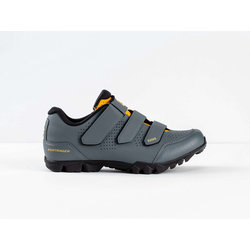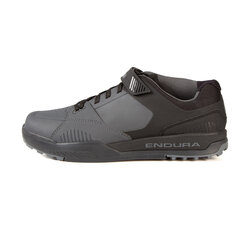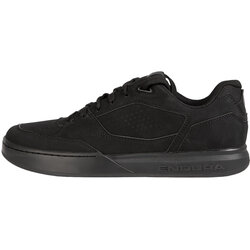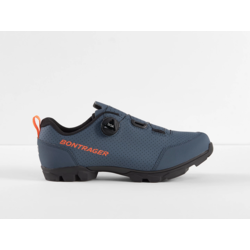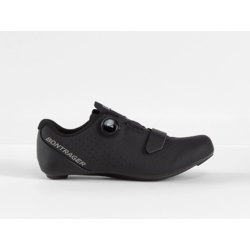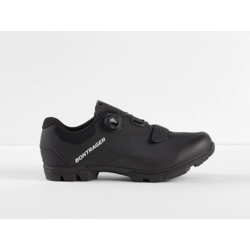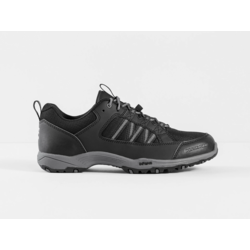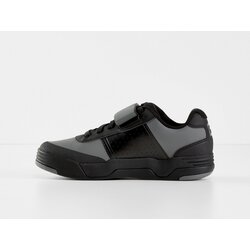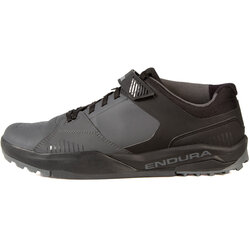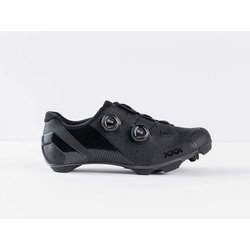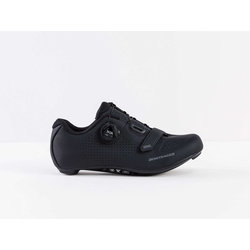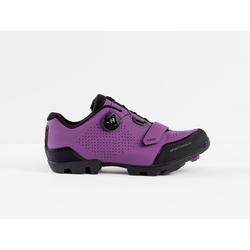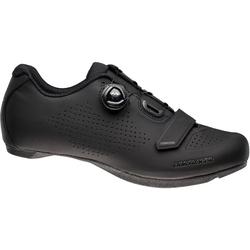Cycling Shoes
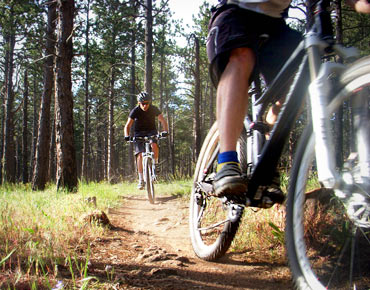 Once you've got a bicycle you really like, and you're riding a fair bit, we recommend considering getting some cycling shoes. This special footwear is loaded with features that make your rides more comfortable, efficient and fun.
Once you've got a bicycle you really like, and you're riding a fair bit, we recommend considering getting some cycling shoes. This special footwear is loaded with features that make your rides more comfortable, efficient and fun.
There are stiff soles that boost your power and protect your feet from the pressure of pedaling, breathable upper to keep you dry, closures that let you fine-tune the fit and other enhancements specific to the type of shoe you're interested in. Plus, a good pair will last a long time.
In this guide we explain the different cycling shoe types with tips on selecting the perfect model. Be sure to contact us if you have any questions. And remember that the best way to evaluate bike shoes is to come visit and try them on.
Shoes for Regular Pedals and Clipless Pedals
There are basic cycling shoes made for regular, flat pedals and shoes with more features for use with clipless pedals. Clipless pedals are popular with experienced road and mountain bikers because they lock onto the clipless shoes (like how step-in ski bindings work) providing top-notch pedaling efficiency and fast and easy pedal entry/exit (the riders in our first photo are using clipless shoes and pedals).
Shoes for standard pedals look like sneakers or sports shoes and boast stylish, tough uppers, grippy soles for holding onto the pedals and walking, and easy-to-use closures. All cycling shoes also have stiffeners in the soles to help with pedaling and protect your feet. On shoes for flat pedals, these stiffeners aren't too stiff because these shoes are for pedaling and walking.
These types of shoes are used for standard road pedals with and without toe clips and straps. And, there are shoes designed for dirt jumping, downhill and freeride mountain biking. The uppers on these shoes may be thicker for protection, support and durability, and the soles are grippy to let you hang onto the pedals with your feet. Some flat pedals have pins in them to help.
Differences in Cycling Shoes
Clipless cycling shoes are more efficient because you can apply power through more of the pedal stroke and the stiffer soles eliminate foot flex, so more energy is transferred to the pedals (see video, right). The stiffer soles and ventilated uppers are also lighter for comfort even on long rides.
Flat-pedal shoes are excellent if you're stopping frequently and walking, like you would on a tour. They're also great for downhillers who need to take their feet off quickly and then get them back on without a second thought. This is most advantageous in off-camber corners or muddy conditions when quick dabs become necessary.
Also BMX and mountain bikers who ride dirt jumps or street will use these shoes so their feet can float on the pedals allowing them to move their bike independently for tricks and style. They are also safer for mid-air bailouts and more convenient for hiking and walking around.
Clipless Shoes Types
Casual Riding: Shoes for casual riding are designed with comfort, walking and ease of use in mind, and therefore tend to be a little more flexible than their super-stiff racing brothers. Many tourists choose casual shoes compatible with clipless pedals because of their versatility. They may wear them for long days of riding (or even throughout a prolonged tour) and appreciate the little extra forgiveness in the soles and the recessed cleats that make walking easy.
Styles vary from boot-like designs to low-cut, almost racing-style shoes with some good compromise models in terms of features, weight and style in the middle ground. Some have lace closures, others have Velcro straps.
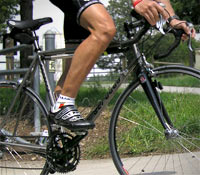 Road Riding: Road shoes have the stiffest soles, made of nylon, composite materials or carbon for maximum pedaling efficiency and minimum weight. These shoes usually sport lightweight ventilated uppers made from leather or synthetic leathers like Lorica, with mesh for breathability. Velcro-strap or ratcheting-buckle closures are popular so that adjustments can be made "on the fly," tighter for climbing or sprinting, looser if your feet swell or feel uncomfortable.
Road Riding: Road shoes have the stiffest soles, made of nylon, composite materials or carbon for maximum pedaling efficiency and minimum weight. These shoes usually sport lightweight ventilated uppers made from leather or synthetic leathers like Lorica, with mesh for breathability. Velcro-strap or ratcheting-buckle closures are popular so that adjustments can be made "on the fly," tighter for climbing or sprinting, looser if your feet swell or feel uncomfortable.
Racers do not need to put their feet down very often, so having recessed cleats is not important. However, standard road cleats that protrude from the soles can make those occasions when you do need to walk a bit awkward.
Fortunately, to provide traction for easier and safer walking and to help protect the cleats, rubber cleat covers are available for many different clipless systems. We recommend picking up a pair and carrying them on rides so you can walk easily and save your cleats from wear and tear.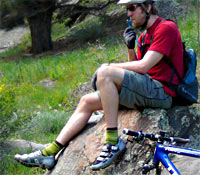 Off-Road: Off-road shoes are also quite stiff and inflexible but not as much as road models. Like the road riders, off roaders want good power transfer through the shoes to the pedals. However, off-road shoes all have recessed cleats and aggressive tread patterns for those occasions when it's necessary to get off and hoof it.
Off-Road: Off-road shoes are also quite stiff and inflexible but not as much as road models. Like the road riders, off roaders want good power transfer through the shoes to the pedals. However, off-road shoes all have recessed cleats and aggressive tread patterns for those occasions when it's necessary to get off and hoof it.
Some shoes even accept optional screw-in studs (also called spikes) near the toes for grip on muddy trails. Uppers are usually a little more robust than on road shoes, to cope with brushing through the undergrowth. Closures can be laces, Velcro straps and buckle-and-strap systems. If laces are used, they're usually hidden by a protective tongue. Soggy laces are no fun to untie when you're tired after a fun ride!
| How you ride... | The shoe for you... |
| You're a casual cyclist who doesn't feel comfortable looking like a gonzo bikie. | Consider casual cycling shoes, which look more like sneakers. There are even cleated models that work with clipless pedals. |
| You love rolling up the miles and you enjoy stopping to admire the view almost as much. | Look at shoes made for touring. They're flexible for comfort with rubber soles and recessed cleats for walking. Off-road styles work, too. |
| You love off-road rides and races. | You want lugged soles, recessed cleats, a snug, comfy fit, light weight, decent sole stiffness (not too stiff) and a secure fastening system. |
| You've been on off-roader and now you plan to get a road bike. | You may want to continue using your off-road shoes. Just get the same pedals for your road bike that you have on your off-roader. |
| You're a serious triathlete. | Check out triathlon shoes, which are designed for high efficiency with features to get in and out quick. |
| You ride centuries and group rides that are more social than competitive. | You'll do fine with a mid-line road shoe because it'll be more flexible and comfortable than the full-on road race model (see below). |
| You enjoy hammering on the road sprinting against your buddies for every city-limit sign. | Get light, high-end road shoes with super-stiff soles for exceptional energy transfer and an extra-secure closure system. |
| You enjoy downhilling, jumps, drops and wooden features. Sometimes you also push to the top of the hill. | Check out our grippy flat-pedal shoes. You can easily put a foot down in precarious situations, whip your bike around for tricks and style and hike to the top of the trail no problem. |
| You want to race downhill and go as fast as possible. | We suggest you learn how to ride both clicked in and on flat pedals. Both teach you valuable techniques. If you’re serious about racing you’ll encounter conditions that favor both. |
Fit
Cycling shoes should fit a little more snugly than your favorite sneakers. You don't want your feet moving back and forth when you pedal and you also don't want your toes rubbing the front of the shoes. Go a little looser for casual/off-road shoes and tighter for road models.
Arch support adds comfort and efficiency, and your heels should stay in place and not move up or down. You should be able to wiggle your toes comfortably.
Wearing cycling socks will help your shoes fit right and keep them that way. Unlike standard sports socks, cycling models are thin so they won't stretch the shoes, ruining the fit.
They are also made of synthetic and/or wool blends to breathe and keep you dry and comfortable (cotton holds onto moisture). A good pair of cycling socks will last a long time.
Note that after rainy/wet rides that soak your shoes, you should stuff them with newspaper so they dry nicely and the fit is maintained.
Two Styles of Clipless Shoes
Just like there are two places to ride, on and off road, there are two types of clipless systems. The most popular are walkable clipless systems, on which the cleats are recessed into the shoe soles (photo: bottom shoe).
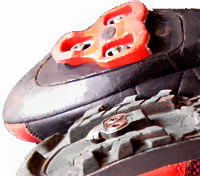 This means the cleats don't contact the ground when you walk so this clipless system is ideal for walking and even hiking. Yet, it's still highly efficient for maximum pedal power. Walkable clipless shoes are ideal for off-road riding, commuting, touring and century riding, too.
This means the cleats don't contact the ground when you walk so this clipless system is ideal for walking and even hiking. Yet, it's still highly efficient for maximum pedal power. Walkable clipless shoes are ideal for off-road riding, commuting, touring and century riding, too.
The other system is road (photo: red cleat) and as the name implies it's designed for use on road bikes where maximum efficiency, aerodynamics and minimum weight are all important. Road shoes are lighter and stiffer than walkable models because the soles aren't lugged.
The other difference in road clipless systems is that the cleats protrude from the soles of the shoes because the soles are so thin and light. This makes it difficult to walk in the shoes (though there are rubber cleat covers available to protect the cleat and improve traction).
Styles Of Flat-Pedal Shoes 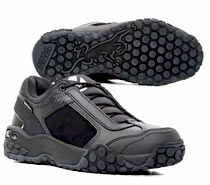 Flat-pedal biking shoes come in a variety of styles, however there are a couple key features to consider. The first being the type of sole and rubber that will suit your riding best. Thick, sturdy soles offer great support, which keeps the arches of your feet from fatiguing on long bumpy downhill runs or cross-country rides.
Flat-pedal biking shoes come in a variety of styles, however there are a couple key features to consider. The first being the type of sole and rubber that will suit your riding best. Thick, sturdy soles offer great support, which keeps the arches of your feet from fatiguing on long bumpy downhill runs or cross-country rides.
It also offers protection for quick dabs or when you have to dismount quickly in rocky terrain. These thicker soles should also be complemented with a sticky rubber tread. Pedals with pins will sink into the rubber holding your feet in place for control. As you can guess, these types of shoes are preferred by downhillers and aggressive trail riders.
Some riders, however, prefer shoes with thinner more-flexible soles. They allow you to be precise with the movement of the bike and the forces that are absorbed and exerted on the pedals. Also these softer soles allow you to cup the pedals for a good grip or to float on the pedals freely. This is key for certain tricks. Often you’ll see trials, park riders and dirt jumpers using these softer-soled shoes.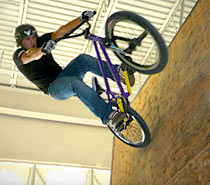
The second thing to consider is how much support you want around your ankles. Popular styles are often available in mid- or high-top versions. This extra material around your ankles protects them from rocks and debris that can be dislodged by your tires. It also protects your ankles from being torqued too much in one direction. On the flip side, the flexion in your ankles will be more restricted.
When it comes to flat-pedal shoes, you may need to go through a couple of different styles before you know what you like. As your riding style changes and progresses, you may find your preference in shoes will also change.
Getting Used To Riding Clipless
So you’ve decided on clipless shoes. Here are some suggestions to help you get going safely. The most important thing is practicing before hitting the road or trail. This is especially important if you started with toe clips and straps, which require a different foot motion to get your feet out. Clipless pedals release by swinging your heels outward (photo below).
Teach your feet this motion while standing over the bike. You're just going to practice getting your feet in and out, not sit on the seat or ride anywhere. If you're worried about falling over, practice on a lawn or soft surface. Even better, if you have an indoor trainer, mount your bike on it and practice in place (photo).
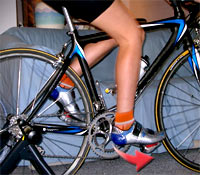 Click your right foot into the right pedal and remove it 50 or more times, and repeat with your left. It should begin to feel natural and easy. Keep clicking and releasing until you've really got it down. You're training your muscle memory until you can do this without thinking about it — even better: without looking down!
Click your right foot into the right pedal and remove it 50 or more times, and repeat with your left. It should begin to feel natural and easy. Keep clicking and releasing until you've really got it down. You're training your muscle memory until you can do this without thinking about it — even better: without looking down!
When you're comfortable getting in and out of the pedals, do a short loop around the neighborhood and practice entering and exiting the pedals for real. The trickiest thing the first couple of times is remembering to swivel your heels to get out instead of pulling back (the toe-clip motion). As long as you keep the correct motion in mind you'll get your feet out just fine.
If you're worried about it, plan your neighborhood test loop to end next to a telephone pole you can hang onto for insurance. Remember too that you don't have to stop if you're not ready to get your feet out. Just keep riding and find something to hold onto like a parked car or parking meter, and then click out of the pedals.
If you're still having trouble getting in and out of the pedals, practice some more while standing next to the bike. There might also be something making it harder to get out of the pedals, such as a too-tight adjustment, a misaligned or loose cleat. If that's the case, be sure to bring your bike and shoes in so we can have a look, solve any problems and get you going.
Buying Tips
Save your bucks. You don't have to buy a company's most-expensive model to get great clipless shoes. What that extra cash buys you is lighter weight, a little more durability and sometimes added adjustability. If you don't need these extras, save your loot and go with a budget model. You'll still get excellent pedal power.
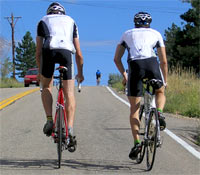 Know your needs. Before shopping for shoes, figure out how you like to ride and what you need from your shoes. Will you walk in the shoes a lot? Do you ride trails, road, both? Are weight and high function important? The better you can define what you want, the easier it'll be for us to help you into the right system.
Know your needs. Before shopping for shoes, figure out how you like to ride and what you need from your shoes. Will you walk in the shoes a lot? Do you ride trails, road, both? Are weight and high function important? The better you can define what you want, the easier it'll be for us to help you into the right system.
Find a fine fit. For road shoes, purchase a glove-like fit. The shoes should be snug with just enough room up front to wiggle your toes. The foot should be held tightly inside the shoe and should not be able to slide forward and back. And your heel should fit snug and not have a tendency to lift. For mountain-biking shoes, the fit is similar except that you may walk in these shoes a lot. So, leave a little more room in the front of the shoe. Mountain biking shoes fit like tight running shoes.
Ride both styles. If you’re serious about racing downhill and will be traveling to different venues, it’s a good idea to learn how to ride both clipped in and on flat pedals. You’ll learn different techniques and your riding will be much more well-rounded.
Make sure they match. Proper shoes, pedals, clips and/or cleats working as a system are important for maximum pedaling efficiency. Be sure your shoes, cleats and pedals are compatible! If you have any questions, just ask.
In closing, when you're shoe shopping, don't underestimate the importance of trying them on. Some brands run wider than others. Some sole shapes may fit your feet better than others. Some brands run big and some run small. No matter how much you like the look or features of a shoe, a lousy fit can ruin rides. So, it's always best to come in and try some on. We look forward to answering your questions and helping you find the perfect shoes!

